Warkworth Town Hall Talks are all action
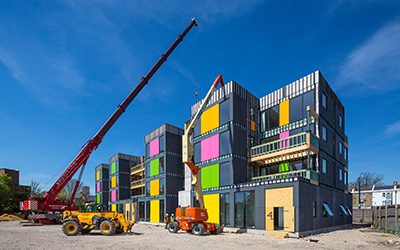
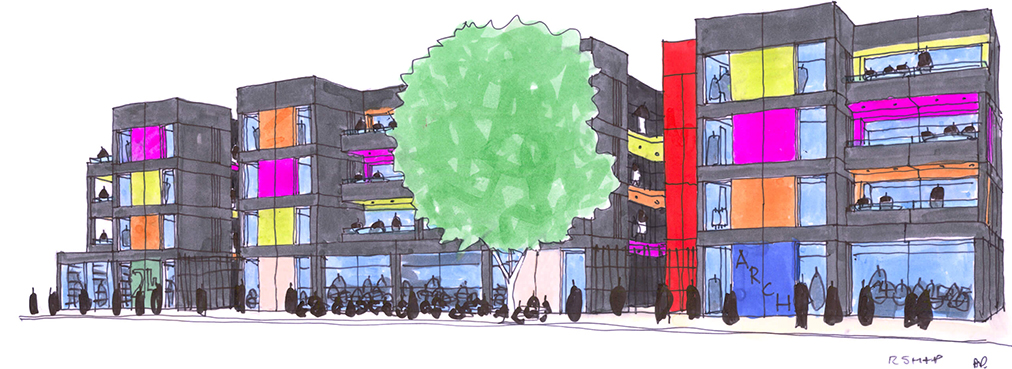
Quiet Revolution: Just one of the many downsides of being ordained a satellite growth centre is being condemned to perpetually live in a construction zone. Lewisham Council’s Ladywell development spared its neighbours years of dust and disruption by having Rogers Stirk Harbour and Partners design factory-build modules that could, for example, be relocated and reassembled as part of an orderly retreat ahead of 66-metre sea-level rise. Further, the engineered-wood dwellings contribute only a tiny fraction of the atmospheric carbon dioxide contributed by steel and concrete construction causing that sea-level rise. image Rogers Stirk Harbour + Partners
Wednesday night’s wonderful, wonderfully well-attended town-hall talk wasn’t supposed to happen and wouldn’t have, had Auckland Council not hired Adrian and Alex Hayward to promote the use of the Warkworth Town Hall.
The same day Adrian and Alex were introduced to the community, former Mahurangi West—and inaugural Oaks on Neville—resident J Barry Ferguson, hearing of this, offered to pay for the projector and motorised screen that were christened Wednesday, by Bill McKay with his dynamic Life at the End of the Motorway talk. The cost of hired audiovisual equipment of remotely town-hall scale, and the chore of collecting it from and returning it to Penrose, had forced a hiatus on the Warkworth Town Hall Talks.
The objective of the Warkworth Town Hall Talks is action. Initiated 15 months ago by Mahurangi Action and One Warkworth, and supported by the Mahurangi Matters, the spinoff has been too considerable to be covered here, but it climaxed with August’s talk by Dr Andrew Jeffs. Dr Jeffs’ town-hall talk sparked a 5-year, potentially $1 million research project aimed at developing practicable methods of restoring the Hauraki Gulf’s green-lipped mussel reefs at scale, and the germ of another, 5-year $1 million project. Mussels once carpeted between 500 and 1000 square kilometres of the gulf seafloor, providing habitat for juvenile snapper, clarifying the water column, and sequestering carbon dioxide. Given the calamitous implications of Global Warming of 1.5 °C, every action hereon must be a climate action.
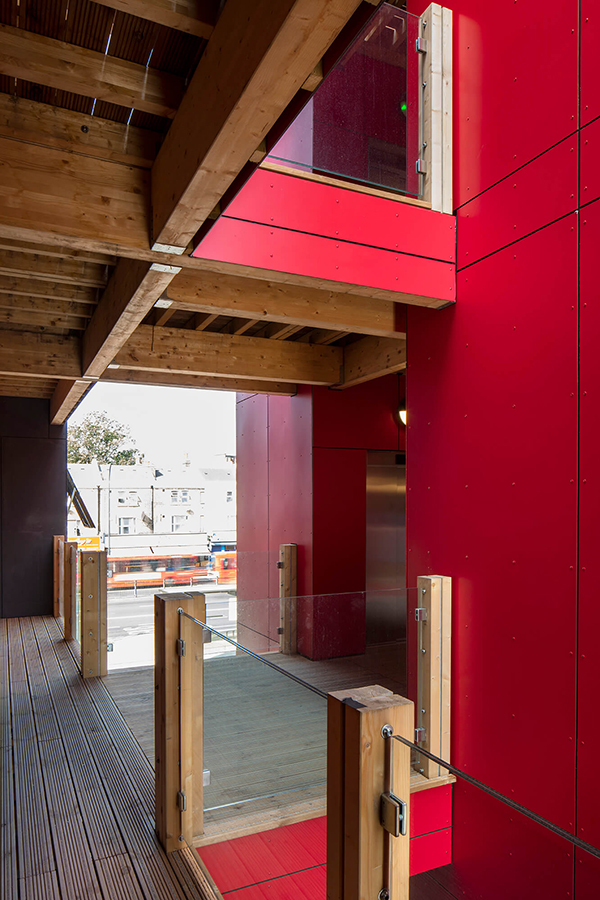
And Aotearoa Exports Logs: Rather than milk cows and export mountains of coal-dried milk powder, New Zealanders should be employed planting, harvesting, engineering, manufacturing and exporting buildings of radiata pine, which if deployed intelligently will last for centuries. Every spare scrap of land should be planted, favouring indigenous species where they will perform the triple service of attenuating sedimentation, restoring biodiversity, and sequestering carbon dioxide. With less unconscionable climate-action procrastination, most plantings could now consist of natives, but Global Warming of 1.5°C has robbed Aotearoa of that option. image Rogers Stirk Harbour + Partners
Forty-four years ago, Mahurangi Action was formed in reaction to sewerage plans by the Warkworth Town Council, which were inadequate to make the Mahurangi River swimmable, and far from the greatest selling point for the oyster farms downstream. Two years later, to demonstrate that it wasn’t just about reacting to things the council proposed, the organisation revived the Mahurangi Regatta, which had lapsed during World War II. This summer’s regatta will be used to spread the word on the Mahurangi mussel action, and to recruit supporters. Because while $250 000 has already been pledged, numbers count when it comes to securing complementary funding from gift—a Foundation North gulf initiative—and other funders. This research is crucial. Unless smarter means can be developed for green-lipped mussel reef restoration, the $50 billion current cost of restoring reefs with adult mussels means that the gulf will remain muddy—indeed muddier, thanks to increasingly extreme extreme-weather-events that are responsible for the bulk of sediment generation.
Bill McKay’s talk contained cautionary tales of where, historically, preoccupation with getting new-housing-initiative runs on the board backfired, and mentioned the One Billion Trees $160 000 mulched seedlings debacle. Sadly, this will be but the tip of the iceberg in the hastily conceived programme, judging by the motorising-the-wheelbarrow thinking evident. McKay’s suggestion that the spectacular post-World War II state-housing build was an unreplicatable product of a command-and-control environment, however, needs to be challenged. Given the imperative to switch with urgency to practicable, purpose-ready, scalable low-carbon technologies, to replace currently fossil-fuel-burning infrastructure, it is unconscionable to refuse to consider the once default option of placing the country—placing all countries—on the equivalent of a world-war footing. The public must urgently persuade political parties to collectively put planet before party, and the immediate electoral term.
With Dunedin City Council determining that all new buildings, identified areas of coastal hazard in South Dunedin are to be relocatable, as should have been the case long since, the writing is on the seawall for the laissez-faire of neoliberalism. The mobilisation that was probably always going to be necessary, even if every conceivable economic lever—from impossibly implausible emissions trading schemes, to excoriating carbon taxes—was pulled until it bent, is now the only path left. Without war cabinets specifying and procuring low-carbon resources, and war rooms to deploy personnel and equipment, escalating impacts on existing, high-carbon infrastructure will quickly overwhelm the ability of even a highly incentivised market to respond remotely adequately.
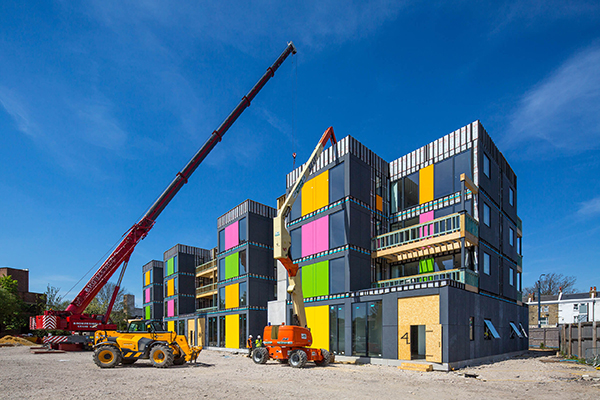
Likes of Ladywell: Building onsite in concrete and steel, as the Oaks on Neville has just demonstrated, is an extremely long and disruptive—in the non-buzzword sense—process and is a high-carbon methodology contributing substantially to global warming. The likes of the Ladywell factory-built accommodation here, which can be relocated and reassembled, is all that should now be permitted, without powerful extenuating circumstances. image Rogers Stirk Harbour + Partners
And the latter-day analogy of the jeep is emphatically not an electric car, autonomous or otherwise. As much as Elon Musk and other self-serving skin-deep ecoskin-deep, in respect to the eco prefixmodernists deride the idea as outdated and unnecessary, public transport, electrified, and smarter by the day. Public transport is the only intervention studied that puts a dint in the otherwise intractable pandemic of noncommunicable diseases. Rather than the once heroic jeep, it is high-quality, long-lasting factory-built transportable accommodation, built predominantly—and not just in Aotearoa—of radiata pine, processed and protected in such a way that the carbon it so consummately extracts from the atmosphere as it grows is sequestered for centuries. Judging by their legendary longevity in cold, dry climates, the life of an optimally-engineered wooden building can be estimated in centuries rather than the few dismal decades with the current crude, increasingly criticised, regulatorily-permitted methods.
A significant and practicable climate action would be to build the, essentially new, Mahurangi tidehead town of 30 000, of durable, factory-built, engineered timber, relocatable dwellings.
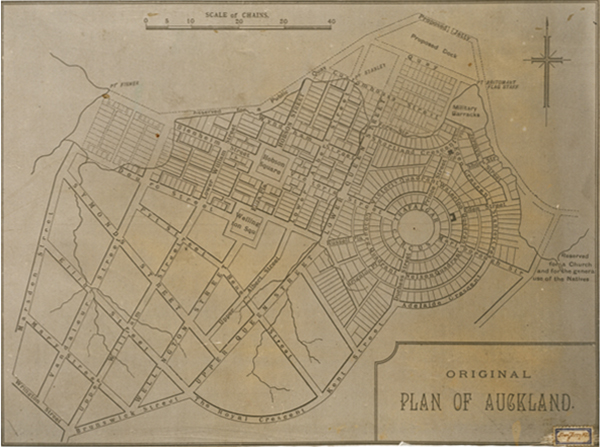
Super Garden City: Sixty years ahead of the Garden City curve, Felton Mathew’s grand, greatly mocked circular design, for what arguably might better have been named Waitematā, for the then sparkling waters of its magnificent harbour location. Its circular heart was almost completely obliterated, by later pragmatists. plan Sir George Grey Special Collections | Auckland Libraries
Sour Footnote It is an appallingly tragic irony that a species that holds so much climate-action potential, radiata pine, is popularly maligned in the country that is the world leader in its deployment. Misinformation abounds and goes mostly unchallenged, whereas:
As the wholesale conversion of New Zealand forestry to dairying attests, radiata pine does not ‘poison’ the soil such as by making it irretrievably acidic—rimu and kauri are vastly more powerful soil acidifiers. What is also tragic is that few environmentalists have supported, much less advocated for, indigenous forestry, contributing to why timber of indigenous species is not available in volume—now, when it is needed most—to sequester carbon in objects too valuable to ever be burned or allowed to decompose. That is not to absolve the forestry industry from practices that sometimes rival some in the fishing industry for blatant disregard for downstream effects.
